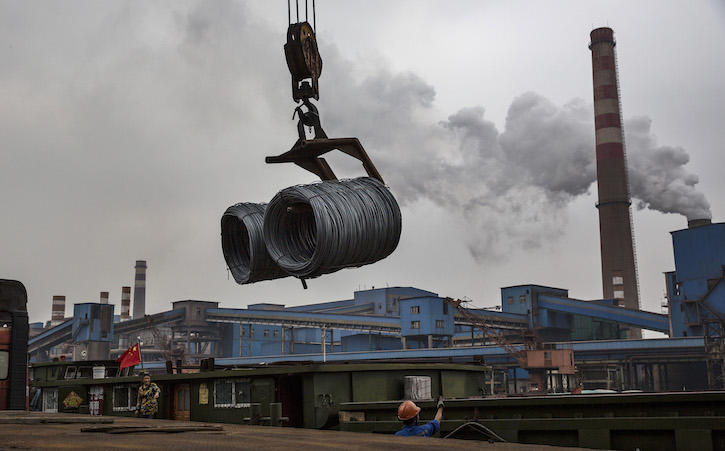
By Houze Song
As China’s economy continues to slow, Chinese and western economists have been trying to find a silver-bullet solution that will stabilize the economy, build confidence, and stem the outflow of capital. Many are struggling for ways to boost China’s growth rate, which has slowed to some 6.5 percent after decades of double-digit growth. Most recently, former U.S. Federal Reserve Chairman Ben Bernanke suggested in a blog post that a well-designed fiscal stimulus program could solve China’s current challenges while also making the economy more sustainable. Bernanke writes that a deficit-funded transfer of funds to consumers would encourage household consumption, and as a result increase total expenditure in the economy, ultimately boosting growth.
But stimulus designed to boost economic growth will not help China’s economy in the medium or long term. Why? Because more growth is not the answer. What people are forgetting is that since the financial crisis of 2008, the Chinese government has been artificially pumping up growth with a massive investment-led stimulus program. In response to the global financial crisis in 2008, Beijing introduced a combination of fiscal and credit programs to boost the economy. As a result, total credit in the economy grew by more than 30% in 2009. As an economy recovers, government expenditure should be reduced and loose credit policies should be scaled back—leading to declining fiscal deficits and slower credit growth. But neither has happened in China. China’s credit growth didn’t decline to its pre-crisis level until 2013. And since the growth of credit in China is on such a large base, the level of cumulative credit expansion is truly remarkable. China’s debt to GDP ratio has jumped from 150% to more than 200%. Therefore, even at 6.5 percent, the Chinese economic growth isn’t based on economic fundamentals.
In theory, Bernanke’s proposal makes sense. Using fiscal stimulus to increase short-term GDP is a standard prescription, and you can find it in almost all macroeconomic textbooks. Traditionally, governments implement fiscal stimulus when output or employment levels are below their potential as a way to boost growth.
But the problem is with the validity of the preconditions for stimulus, i.e., the assumption that China’s economic growth is below potential. The recent economic slowdown has led people to wonder whether Beijing has exited from its stimulus efforts. But the truth is that China’s central and local governments have merely stopped increasing their stimulus. Consider a hypothetical case, in which a government permanently increases spending by $100 billion per year. In year one, there will be a positive growth effect, but from year two onwards, although the size of economy will have been permanently increased, the impact on the growth rate will be zero. This is exactly what has happened in China. The IMF estimates that China’s overall government deficit has increased from 6 percent of GDP before 2008 to 12 percent in 2009, and stabilized at around 9 percent since 2012. In other words, Beijing has not reversed its course, but has kept its stimulus growing at a rate close to overall economic growth. In the meantime, a large amount of China’s economic growth following 2008 was “created” by the government.
Therefore, it seems unlikely that the Chinese economy is growing below its potential—meaning that any large-scale government stimulus, whether investment-led or consumer-focused, would likely further distort the economy, potentially leading to more resource misallocation. Had China’s local governments been running smaller deficits, the level of China’s GDP would be lower than it is today. And during the fiscal consolidation process, the growth rate would also be lower. In other words, China’s growth has been faster than its not-stimulus potential (or potential under a smaller government) over the past couple of years. The current “lack of demand” is not because growth is too slow; it is a consequence of past stimulus efforts to create demand through investment.
Many economists and market players forget that stimulus in China is different from stimulus in market-driven economies, where the majority of fiscal spending is usually aimed at boosting consumption. The end result in market economies: too much consumption eventually leads to inflation. But China’s government approaches stimulus differently, resulting in the opposite effect: it has been directing the majority of stimulus spending to state-led investment that increases future production capacity. Inevitably, that has led to excess capacity—factories churning out products that no one wants. In other words, deflation.
Contrary to many economists’ analysis, the excess capacity we see in China has nothing to do with the economy functioning below its potential. The economic potential is simply not configured to accommodate the build-up of production capacity. Any investment should ultimately serve consumption either directly or indirectly. Boosting growth artificially through investment to create demand for past investments is like a Ponzi game. China can still play such a game for a while. But eventually, anything that is not sustainable has to stop, and it is better to stop it earlier than later.
[contentblock id=24 img=gcb.png]


